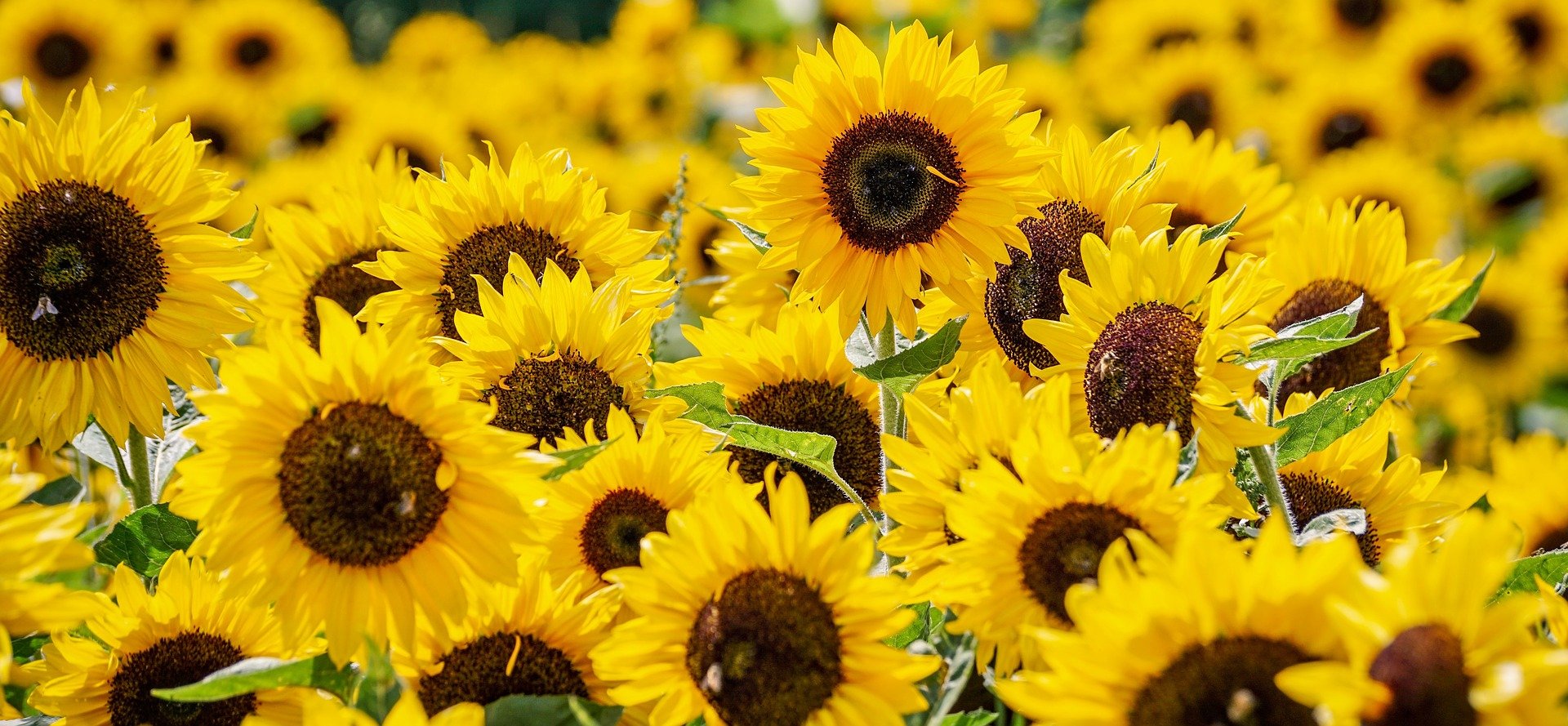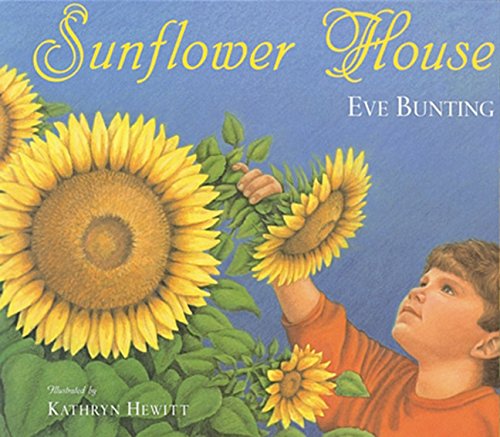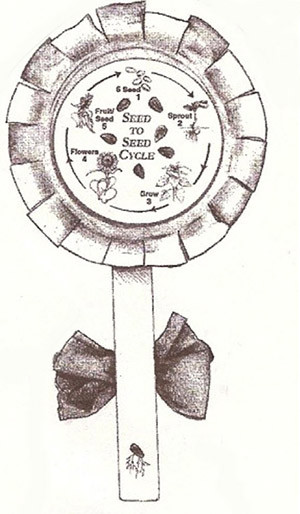Lesson Plan
Sunflower Life Cycles
Grade Level
Purpose
Students observe the growth and development of sunflowers, identify how sunflower seeds are used, and make a paper plate sunflower to illustrate the life cycle of the sunflower. Grades K-2
Estimated Time
Materials Needed
- Sunflower Growth Stages Pictures
- Small white paper plates – one per student
- Seed to Seed Cycle diagrams copied on orange or yellow paper – one per student
- Large craft sticks or popsicle sticks – one per student
- These can be purchased at craft stores – most sizes will work for this activity
- Sunflower seeds – at least 6 per student
- Green paper, cut into 1” pieces
- Sunflower heads or pictures of sunflower heads
- Glue and/or Tape
- Crayons
- Sunflower House by Eve Bunting
Vocabulary
life cycle: the stages a living thing goes through in its lifetime
Did You Know?
- Sunflowers are primarily grown in North and South Dakota. Several other states, such as Minnesota and California, also produce sunflowers.
- Kansas is called the Sunflower State!
- The average yield of sunflower seeds is 1,513 pounds per acre.
Background Agricultural Connections
Farmers in the United States grow sunflowers. There are many varieties of sunflower. Most people recognize sunflowers as an ornamental flower in a garden or a bouquet. However, sunflowers are actually an agricultural crop that has many uses. When farmers grow sunflowers, they grow them to harvest their seeds. The seeds can be used for birdseed and livestock feed. They can also be used for snacks, toppings on salads, and cooking oil.
Sunflowers are native to North America, and are thought to have originated where the states of Arizona and New Mexico are now located. Sunflowers have a deep root system that allow them to maximize soil water. Sunflowers can be pressed for oil. Sunflower oil is a trans-fat-free vegetable oil.
Sunflowers are grown from seed. Like most crops, they are planted in the spring and harvested in the fall. Their life cycle begins and ends with a seed. The seed is planted, germinates, grows to maturity, and then flowers. The head of the flower contains many seeds. At the end of the life cycle the head of the flower becomes heavy and drops. At this time the flower is harvested and the seeds are collected for processing and either human or animal consumption.
Engage
- Tell students that you are going to give them some clues and that you want them to guess what kind of flower you are thinking of. Use all or some of these clues:
- This flower has a green stem and leaves.
- The petals of this flower are usually yellow.
- This flower can be more than 10 feet tall when it's full grown.
- This flower produces seeds that sometimes we like to eat.
- "What flower is it? (A sunflower!)

Explore and Explain
Activity 1: Sunflower Lifecycle
- Read the book, Sunflower House, by Eve Bunting to the students. As you read, Discuss with students the meaning of a “life cycle.” Point out the steps of the sunflower lifecycle as you read the story.
- Show students the Sunflower Growth Stages pictures. Show the students an actual sunflower head with the seeds inside if you can, but if not, use the pictures provided with this lesson. Go through each step of the cycle. Place the pictures on the board with tape or a magnet and leave them for the next activity.

Activity 2: Paper Plate Sunflowers
- Distribute the activity supplies.
- Glue the Seed to Seed Cycle in the middle of the paper plate, and set aside.
- Ask students what the first step in the Seed Cycle is (seed). Have students glue one sunflower seed about 1” up the craft stick, as if they were planting a seed in the ground and the stick is the stem that would grow from the seed.
- Ask students what the next step in the cycle is (sprout). Talk with them about what is needed for a seed to germinate. Have students draw roots on their craft stick below the seed with the brown crayon.
- Ask students what the next step is (grow). As the stems and leaves begin to grow, have students cut out leaves from the green paper and glue them to the stick above the seed.
- Ask students what step 4 is (flower). Have them color the white paper plate around the Seed to Seed Cycle. Use scissors to snip the plate edges to the center circle to create flower petals.
- Talk with students about step 5 (fruit). Students should glue sunflower seeds to the center of the Seed to Seed Cycle.
- Tape or glue the paper plate flower to the craft stick.

Elaborate
- Have students work through the life cycle beginning at different starting points. You could act out each stage and play charades play Pictionary and draw each stage to review and check for understanding.
- Read the book Seed, Soil, Sun: Earth's Recipe for Food by Cris Peterson.
Evaluate
After conducting these activities, review and summarize the following key concepts:
- Sunflowers are grown by farmers for the seeds and oil they produce.
- The life cycle of a sunflower begins and ends with a seed.
Acknowledgements
This lesson was adapted from Growing in the Garden.
Recommended Companion Resources
- A Seed Grows
- Alfalfa Seeds
- Before the Plate Website
- Big Yellow Sunflower
- Flower Garden
- Garden Planner
- How Do Flowers Grow?
- Jr. Sprout – Gardening
- Miguel's Community Garden
- Oilseeds Flowchart
- Plant Secrets
- Seed, Soil, Sun: Earth's Recipe for Food
- Sunflower House
- Sunflower Life Cycle
- The Amazing Life Cycle of Plants
- The Great Pumpkin
- The Tiny Seed
- This is the Sunflower
Author
Organization
| We welcome your feedback! If you have a question about this lesson or would like to report a broken link, please send us an email. If you have used this lesson and are willing to share your experience, we will provide you with a coupon code for 10% off your next purchase at AgClassroomStore. |
State Standards for Texas
ELA: K.110.2.b.1
Developing and sustaining foundational language skills: listening, speaking, discussion, and thinking - - oral language. The student develops oral language through listening, speaking, and discussion.
- ELA: K.110.2.b.1.C - share information and ideas by speaking audibly and clearly using the conventions of language
- ELA: K.110.2.b.1.D - work collaboratively with others by following agreed-upon rules for discussion, including taking turns;
ELA: 1.110.3.b.1
Developing and sustaining foundational language skills: listening, speaking, discussion, and thinking - - oral language. The student develops oral language through listening, speaking, and discussion.
- ELA: 1.110.3.b.1.C - share information and ideas about the topic under discussion, speaking clearly at an appropriate pace and using the conventions of language
- ELA: 1.110.3.b.1.D - work collaboratively with others by following agreed-upon rules for discussion, including listening to others, speaking when recognized, and making appropriate contributions
ELA: 2.110.4.b.1
Developing and sustaining foundational language skills: listening, speaking, discussion, and thinking -- oral language. The student develops oral language through listening, speaking, and discussion.
- ELA: 2.110.4.b.1.C - share information and ideas that focus on the topic under discussion, speaking clearly at an appropriate pace and using the conventions of language
- ELA: 2.110.4.b.1.D - work collaboratively with others by following agreed-upon rules for discussion, including listening to others, speaking when recognized, making appropriate contributions, and building on the ideas of others
Social Studies: 2.113.13.c.16
Social studies skills. The student communicates in written, oral, and visual forms. The student is expected to:
- Social Studies: 2.113.13.c.16.E - communicate information visually, orally, or in writing based on knowledge and experiences in social studies
- Social Studies: 2.113.13.c.16.F - create written and visual material such as stories, maps, and graphic organizers to express ideas
Social Studies: K.113.11.c.14
Social studies skills. The student communicates in oral and visual forms. The student is expected to:
- Social Studies: K.113.11.c.14.C - communicate information visually, orally, or in writing based on knowledge and experiences in social studies
- Social Studies: K.113.11.c.14.D - create and interpret visuals, including pictures and maps
Social Studies: 1.113.12.c.17
Social studies skills. The student communicates in oral, visual, and written forms. The student is expected to:
- Social Studies: 1.113.12.c.17.C - communicate information visually, orally, or in writing based on knowledge and experiences in social studies
- Social Studies: 1.113.12.c.17.D - create and interpret visual and written material
Science: 2.112.4.b.1
Scientific and engineering practices. The student asks questions, identifies problems, and plans and safely conducts classroom, laboratory, and field investigations to answer questions, explain phenomena, or design solutions using appropriate tools and models. The student is expected to:
- Science: 2.112.4.b.1.A - ask questions and define problems based on observations or information from text, phenomena, models, or investigations
Science: K.112.2.b.1
Scientific and engineering practices. The student asks questions, identifies problems, and plans and safely conducts classroom, laboratory, and field investigations to answer questions, explain phenomena, or design solutions using appropriate tools and models. The student is expected to:
- Science: K.112.2.b.1.A - ask questions and define problems based on observations or information from text, phenomena, models, or investigations.
Science: K.112.2.b.2
Scientific and engineering practices. The student analyzes and interprets data to derive meaning, identify features and patterns, and discover relationships or correlations to develop evidence-based arguments or evaluate designs. The student is expected to:
- Science: K.112.2.b.2.B - analyze data by identifying significant features and patterns.
Science: K.112.2.b.5
Recurring themes and concepts. The student uses recurring themes and concepts to make connections across disciplines. The student is expected to:
- Science: K.112.2.b.5.A - identify and use patterns to describe phenomena or design solutions.
- Science: K.112.2.b.5.D - examine the parts of a whole to define or model a system.
- Science: K.112.2.b.5.G - describe how factors or conditions can cause objects, organisms, and systems to either change or stay the same.
Science: K.112.2.b.12
Organisms and environments. The student knows that plants and animals depend on the environment to meet their basic needs for survival. The student is expected to:
- Science: K.112.2.b.12.A - observe and identify the dependence of plants on air, sunlight, water, nutrients in the soil, and space to grow.
Science: K.112.2.b.13
Organisms and environments. The student knows that organisms resemble their parents and have structures and undergo processes that help them interact and survive within their environments. The student is expected to:
- Science: K.112.2.b.13.C - identify and record the changes from seed, seedling, plant, flower, and fruit in a simple plant life cycle.
Science: 1.112.3.b.1
Scientific and engineering practices. The student asks questions, identifies problems, and plans and safely conducts classroom, laboratory, and field investigations to answer questions, explain phenomena, or design solutions using appropriate tools and models. The student is expected to:
- Science: 1.112.3.b.1.A - ask questions and define problems based on observations or information from text, phenomena, models, or investigations.
Science: 1.112.3.b.2
Scientific and engineering practices. The student analyzes and interprets data to derive meaning, identify features and patterns, and discover relationships or correlations to develop evidence-based arguments or evaluate designs. The student is expected to:
- Science: 1.112.3.b.2.A - identify basic advantages and limitations of models such as their size, properties, and materials.
Science: 1.112.3.b.5
Recurring themes and concepts. The student uses recurring themes and concepts to make connections across disciplines. The student is expected to:
- Science: 1.112.3.b.5.A - identify and use patterns to describe phenomena or design solutions.
- Science: 1.112.3.b.5.D - examine the parts of a whole to define or model a system.
Science: 1.112.3.b.12
Organisms and environments. The student knows that the environment is composed of relationships between living organisms and nonliving components. The student is expected to:
- Science: 1.112.3.b.12.A - classify living and nonliving things based upon whether they have basic needs and produce young.
Science: 2.112.4.b.2
Scientific and engineering practices. The student analyzes and interprets data to derive meaning, identify features and patterns, and discover relationships or correlations to develop evidence-based arguments or evaluate designs. The student is expected to:
- Science: 2.112.4.b.2.A - identify basic advantages and limitations of models such as their size, properties, and materials
Science: 2.112.4.b.5
Recurring themes and concepts. The student uses recurring themes and concepts to make connections across disciplines. The student is expected to:
- Science: 2.112.4.b.5.A - identify and use patterns to describe phenomena or design solutions
- Science: 2.112.4.b.5.D - examine the parts of a whole to define or model a system
Science: 2.112.4.b.12
Organisms and environments. The student knows that living organisms have basic needs that must be met through interactions within their environment. The student is expected to:
- Science: 2.112.4.b.12.A - describe how the physical characteristics of environments, including the amount of rainfall, support plants and animals within an ecosystem
- Science: 2.112.4.b.12.C - explain and demonstrate how some plants depend on other living things, wind, or water for pollination and to move their seeds around
Science: 2.112.4.b.13
Organisms and environments. The student knows that organisms have structures and undergo processes that help them interact and survive within their environments. The student is expected to:
- Science: 2.112.4.b.13.A - identify the roots, stems, leaves, flowers, fruits, and seeds of plants and compare how those structures help different plants meet their basic needs for survival
